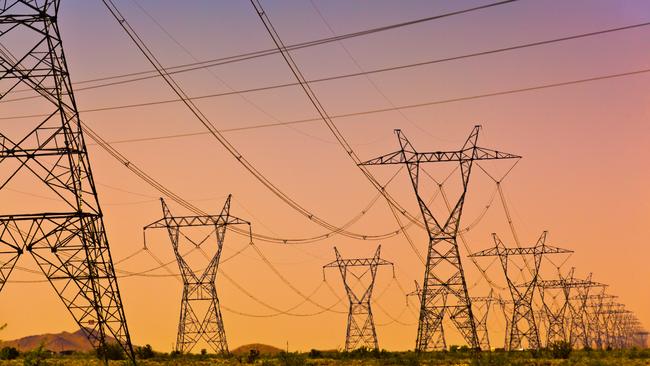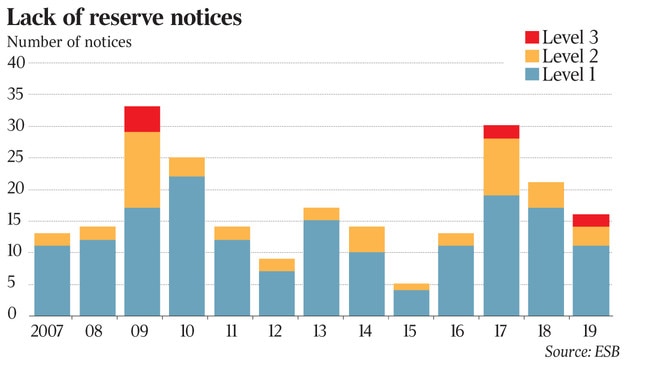Nation’s power grid ‘unreliable’ as risks mount
The reliability of the nation’s power grid has deteriorated as severe weather and ageing coal plants raise new system risks.

The reliability of the nation’s power grid has deteriorated to critical status as severe weather and ageing coal plants raise new system risks while investor confidence has been damaged by government intervention, the Energy Security Board has warned.
Australia’s energy market agency upgraded its assessment of the current challenges posed by electricity reliability to critical from moderate a year ago, given the challenges of keeping the power system stable.
The nation’s energy tsar Kerry Schott said soaring temperatures in several states over the peak summer period in 2018-19 had triggered high demand for electricity, stretching parts of the grid as they scrambled to secure sufficient supplies.
The reliability issue emerged again this summer in late January after wild weather triggered the South Australian interconnector to shut down, cutting electricity to Victoria’s giant Portland aluminium smelter and forcing the national power operator to find emergency supplies to keep the lights on in heatwave conditions.
“The severe weather when you have very hot days in NSW, Victoria and South Australia pretty much concurrently is a big challenge for grid reliability,” Ms Schott, chairman of the Energy Security Board, told The Australian. “When you have two states having temperatures over 40 degrees, it’s quite unusual. You start to see a big focus on ensuring you have the right mix of supplies to get through those tight days.”
While the longer-term outlook for reliability improved to moderate, the tightening of supply and demand, combined with extreme weather and outages at major coal and gas plants, caused South Australia and Victoria to suffer load shedding during the year, the ESB’s annual report on the health of the national electricity market says.

Even though the reliability standard was likely to be met in all regions except Victoria this year, supply is expected to remain tight during summer peaks.
“The reason it is nevertheless rated as critical is that weather events are now more severe, especially over summer, and the thermal generator fleet is ageing and increasingly less dependable,” the ESB said in its report.
The current settings for investors were also upped to critical from moderate, partly due to the federal government’s more interventionist approach to the sector.
“Investor behaviour is rated critical, reflecting the extent of government intervention,” the report noted. “Some government intervention is intended to improve reliable supply but it can also distort the market and lower investor confidence.”
The so-called ‘‘big stick’’ legislation was introduced last year to tackle energy market manipulation and followed Canberra’s introduction of a safety net for electricity prices through the default market offer.
Power giants including Origin Energy and EnergyAustralia have also blamed the government’s underwriting generation scheme for distorting investment signals and making it more difficult to sanction pending projects that would add new baseload supplies to the grid.
Security remains the most pressing concern for the ESB, which noted the power market operator had to intervene 75 times in 2018-19, more than twice as often as the previous year.
While noting rule changes and new markets for frequency control have helped, both the current status and outlook remain critical.
More than 60 per cent or 15 gigawatts of the country’s coal-fired generation will retire by 2040, requiring 30 gigawatts of new large-scale renewable energy to be added, which represents more than half the current capacity of the national electricity market.
Solar and wind will account for 40 per cent of Australia’s electricity by 2030, compared to an estimated 16 per cent in 2018-19, the ESB report estimates.
Coal will contribute less than a third of supply by 2040, down from 70 per cent currently, as solar, wind, gas and hydro dominate the nation’s energy mix.
Ms Schott said handling the pace of the transition to renewables and ensuring the role of gas in the mix was a big focus for the ESB. “We really are up there with a cohort of countries that are bringing in renewables at a fast pace but we need to ensure there is enough back-up power along the way.”
While the market has been aware for years that coal plants will remain under pressure this decade as they reach the end of their operating lives, a new dynamic was their ability to compete with solar during the day.
“As more renewables are coming in they’re proving cheaper than coal and gas and tend to displace them economically during those peak hours during the day,” Ms Schott said.
“So you do get a lot of pressure on the coal plant from an economic and commercial point and that is playing out in the market.”




To join the conversation, please log in. Don't have an account? Register
Join the conversation, you are commenting as Logout